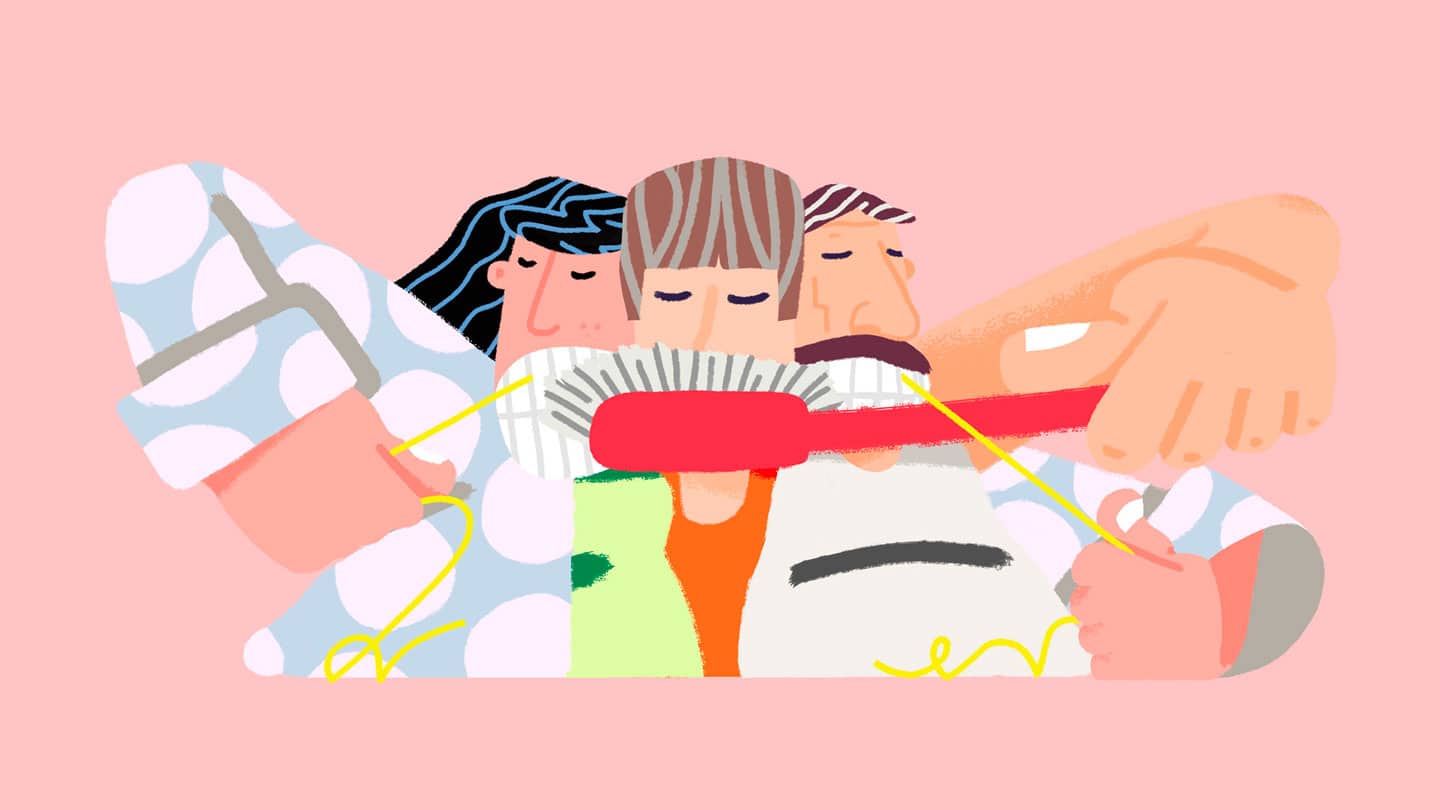Toothpastes come in pastes, gels, and gel/paste combinations. When you use them to brush your teeth, they remove dental plaque, superficial stains, and food residue from the surface of your teeth, gums, and tongue to keep your mouth healthy and looking great.
The inside skinny on toothpaste
- Toothpaste helps prevent cavities and gingivitis and reduces tooth sensitivity and tartar formation,
- Be careful with whitening toothpaste. Many brands are too abrasive and can damage your tooth enamel,
- Babies need toothpaste as soon as their first tooth emerges,
- Having trouble choosing the right toothpaste? Fluoride? Fluoride-free? Talk to your dental hygienist.
Toothpaste and your teeth: therapeutic benefits, cavities, and tooth sensitivity
Toothpaste and cavity prevention
There are two active ingredients that can prevent cavities: sodium fluoride and sodium monofluorophosphate. Several studies have shown that they can reduce cavities by 20% to 30%. Whether you’re 6 or 96, brushing twice a day with a toothpaste that contains one of those ingredients will help keep your mouth healthy.
Toothpaste can reduce tooth sensitivity
Tooth sensitivity is brief but intense pain in your exposed dentin that is caused by heat, pressure, osmosis, or exposure to air or certain chemicals, but is not linked to any other dental issues or diseases.
Two toothpaste ingredients can help reduce tooth sensitivity: potassium nitrate and strontium chloride. Potassium nitrate makes your teeth less sensitive to heat and cold. Strontium chloride makes them less sensitive to touch. Toothpastes with these ingredients can bring relief for sensitive teeth in just a few weeks if you use them as directed.
Reducing tartar buildup above your gums
Pyrophosphate, zinc, and triclosan are some of the active ingredients that can reduce or slow the formation of tartar above your gums. However, they can’t remove existing tartar buildup in your mouth or protect the areas between your teeth and below your gums.
Reducing gingivitis with toothpaste
Brushing your teeth helps reduce and prevent gum inflammation. Using a toothpaste with therapeutic ingredients like triclosan can do even more to keep your gums healthy by reducing gingivitis and dental plaque buildup above your gums.
Teeth whiteners
Your tooth enamel can range in color from white to gray, yellow, or even ocher. It is affected by both internal and external factors. Whitening ingredients in toothpaste can remove light, superficial discoloration.
Toothpaste abrasiveness
Your toothpaste, toothbrush, and brushing technique need to be abrasive enough to get your teeth clean but not so abrasive that they damage your gums or tooth enamel. How abrasive your toothpaste is depends on the size and shape of the particles it contains, its pH, and its glycerin and water content. Other factors that contribute to abrasion are the type of bristles on your toothbrush (soft, medium, or hard), how hard you brush, and whether your roots are exposed, since they aren’t as hard as enamel.
What’s in commercial toothpaste?
- Cleaning and polishing agents: 20% to 40% (e.g. calcium pyrophosphate, silica, etc.)
- Humectants (ingredients that keep the toothpaste soft and wet): 20% to 40% (e.g. glycerol, sorbitol, etc.)
- Water: 20% to 40%
- Preservatives, tooth-safe sweeteners, and plant-based dyes: 2% to 3%
- Binders: 1% to 2% (e.g. cellulose, natural gums, etc.)
- Detergent (foaming agent): 1% to 2% (e.g. sodium lauryl sulfate, etc.)
- Fragrances: 1% to 1.5 % (e.g. mint, cinnamon, etc.)
- Therapeutic agents: 1% to 2%
How much toothpaste should you use?
Babies
As soon as your baby’s first tooth comes in, start brushing with a tiny amount of baby toothpaste twice a day. Use a dab no bigger than a grain of rice.
Children ages 3 and up
Starting at age 3, children can use a pea-sized amount of toothpaste.
Teens and adults
Teens and adults should use about a 1 cm strip of toothpaste.
Carefully spread your toothpaste across all your teeth before thoroughly brushing all surfaces. It’s important to supervise children at least until age 6 to make sure they don’t swallow any toothpaste and that they rinse well after brushing. Read labels carefully! Some toothpastes contain therapeutic agents that aren’t safe for children under age 12. And all toothpaste should be stored out of reach of children.
Low-sugar and low-sodium diets
Even though it tastes sweet, toothpaste doesn’t contain sugar. Instead, it contains sweeteners like sodium saccharin or xylitol that don’t produce a glycemic response, so they’re safe for people living with diabetes.
Some toothpastes also contain sodium bicarbonate, which you probably know as baking soda. You may absorb a small amount of it while brushing, so you will need to take that into account if you are on a low-salt or salt-restricted diet.
Therapeutic fluoride gels
Therapeutic fluoride gels contain more sodium fluoride or stannous fluoride than you find in toothpaste. Since these gels are non-abrasive, they don’t clean your teeth. They are a prescription product used to provide short-term fluoride supplementation if you need it.
What kind of toothpaste should you use?
Your dental hygienist is a highly-trained expert with the experience and knowledge to give you personalized advice on choosing the right tooth care products to maintain and improve your oral health.
There are so many toothpastes on the market that it can be hard to make a decision.
Fluoride-free toothpaste
Fluoride-free toothpaste has been a hot topic lately – but why? Didn’t we all learn in elementary school that fluoride is important for healthy teeth?
It’s true that fluoride is an oligo-element that strengthens your teeth and helps prevent cavities. And up to 2 mg/day of fluoride really is beneficial. But more than that can become toxic and trigger fluorosis, which produces white spots on your teeth.
- Under 0.05 mg/day: good for your teeth (prevents cavities)
- 2 mg/day: risk of dental fluorosis;
- 10 to 40 mg/day: skeletal fluorosis;
- 20 to 80 mg/day: ankylosing fluorosis;
- 100 mg/day: growth delays;
- 125 mg/day: kidney damage;
- 200 to 500 mg/day: lethal dose.
For people at risk of a fluoride overdose, a wide range of fluoride-free toothpastes that are just as effective as fluoride toothpastes are now available. Talk to your dental care professional.
Solid toothpaste
Solid toothpaste is part of a zero-waste lifestyle. It can seem weird at first, but it’s just as effective as traditional toothpaste. To use it:
- wet your toothbrush,
- rub it against the block of toothpaste,
- pick up the foam on your brush,
- use it to brush your teeth.
Humidity is bad for solid toothpaste, so we recommend keeping it in a metal box as a hygiene measure.
Homemade toothpaste: natural, activated charcoal
DIY (Do It Yourself) is increasingly popular, especially when it comes to cosmetics since consumers are looking for more natural products. Dental care is no exception, and you can find dozens of homemade toothpaste recipes online.
Some of those recipes are just as effective as commercial toothpaste, but others contain potentially harmful ingredients. So talk to your dentist before you start experimenting.
One potentially risky ingredient is activated charcoal. While it used to be popular for its abrasive and whitening powers, a series of studies have challenged its usefulness. Activated charcoal in your toothpaste might actually be bad for you.
Baking soda and your teeth
Baking soda or sodium bicarbonate is often used as a safer alternative cleaner.
It can be used as a natural teeth whitener. But it is highly abrasive, so you should only use it as an add-on to regular brushing once or twice a week.
Baking soda is easy to use. Just sprinkle a little on your toothpaste, then brush your teeth as usual.



